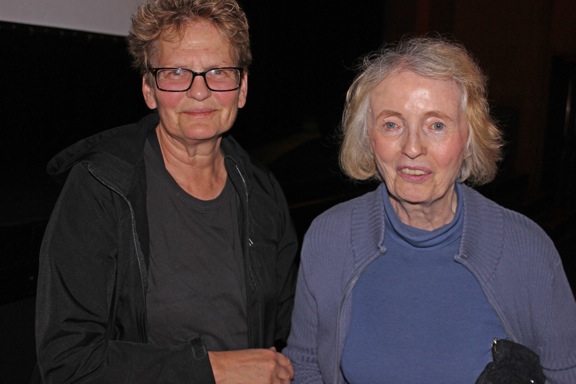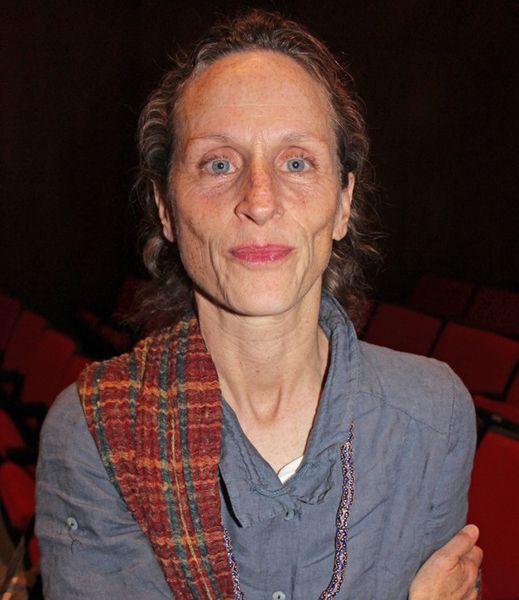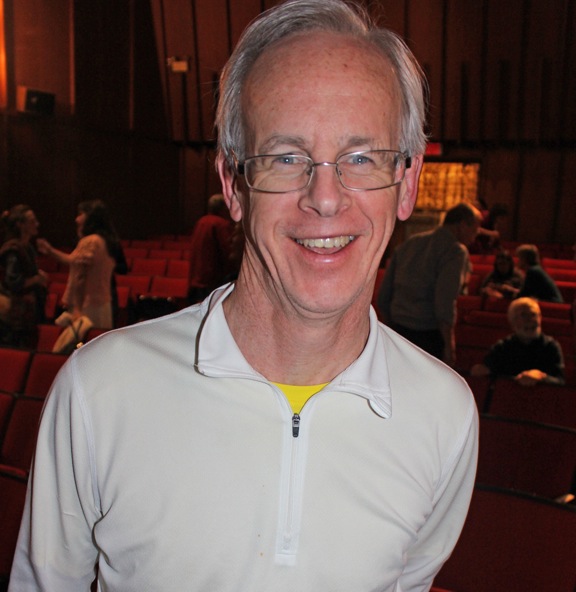ON THE SCENE: 50 years ago in Selma, Alabama

North Country Public Radio Station Manager Ellen Rocco and Kathleen Carroll, artistic director of the Adirondack Film Society (Photo — Naj Wikoff)
Imagine that you are standing in front of a bridge getting ready to walk up and over where just a few weeks ago men and women, young and old, had been savagely beaten by the police. How would you feel?
That’s the situation Ellen Rocco, station manager of North Country Public Radio, found herself 50 years ago in Selma, Alabama.
Then civil rights activists were attempting to march 54 miles from Selma to Montgomery, the state’s capital, seeking the right to vote. They tried three times. About 600 participants in the first try on March 7, 1965, captured live on television by CBS, were brutally beaten back as they crossed the Edmond Pettus Bridge by a mix of state police and county possemen led by then Sheriff Clark, who used teargas, batons, and horses in a savage assault that horrified that nation. The second, held two days later with about 2,500 in attendance, resulted in a standoff. With the way seemingly open to them, Dr. Martin Luther King Jr., obeying a court order, called it off, yet that did not stop four members of the KKK from beating to death James Reed, a white minister from Boston.
Reed’s death further galvanized the American public. During the interim, King and his followers sought through a federal court the right to march, which was granted. The third march was then held on March 21, this time protected by 2,000 soldiers of the U.S. Army, 1,200 members of the Alabama National Guard, and the FBI agents and U.S. marshals ordered by President Lyndon Johnson. Participating in the third march was then 18-year-old Ellen Rocco, who shared her story with those attending a special screening of the film Selma held at the Lake Placid Center for the Arts on Friday, May 15.
While the 15th Amendment, ratified in 1870, prohibited federal and state governments from denying citizens the right to vote based on race, color or previous conditions of servitude, throughout the South many local laws and discriminatory ordinances effectively denied black Americans the right to vote, and of consequence, kept them from have equal justice, representation, and rights under the law that even the historic Civil Rights Act of 1964 passed through the leadership of President Johnson did not fully address. A separate Voting Rights Act was needed, and Martin and the Southern Christian Leadership Conference lobbed hard to get it. They were not willing to wait until some future date, and thus took to the streets as a means of pressuring the president and Congress.

Martha Swan, director of John Brown Lives! (Photo — Naj Wikoff)
The unfolding of this story was the theme of the film “Selma,” the first feature film centered on an aspect of Dr. Martin Luther King’s life. The film was screened twice Friday, at 10 a.m. for 370 area students, and again that evening for the general public. The screenings were organized by John Brown Lives!, the Adirondack Film Society and the Lake Placid Center for the Arts in conjunction with the Saranac Lake Teachers Association and the New York State United Teachers.
Following the evening screening, Rocco shared her experience, as a young participant in the third successful march and walking across the bridge where a couple weeks earlier the bloody confrontation took place and tensions remained high. The inspiration for screening the film was John Brown Lives! founder and president Martha Swan’s going to a multiplex in Plattsburg with her husband Vito to see “Selma” when it was initially released. They were only two of six people viewing the film, while across the hall “American Sniper” was showing to packed houses. Martha felt this portrayal of a seminal moment in our nation’s history needed to be shown to school children so they would have a more visceral understanding of the importance of voting, and what many black Americans in particular were willing to take on to get that right. Further, she felt that in light of the tragic events in Ferguson, Missouri, and Baltimore, the need for seeing and discussing the film was timely.
“I walked out saying, ‘My God, if the schools and teachers aren’t showing this film and we’re not making it available to students then we are doing a disservice to them and to our country,'” said Swan.
At the age of 18, Rocco had been active in the civil rights movement for a couple years and had attended King’s famous “I have a dream” speech held on the Washington Mall in front of the Lincoln Memorial.
“Selma came on the heels of the killing of civil rights workers Goodman, Schwerner and Chaney in Mississippi,” said Rocco. “Andrew Goodman’s family has a connection to the Adirondacks. He was good friend of my boyfriend at the time. Their death was right in my face and followed years of watching on television people being beaten on the streets in the south. I heard that call from Dr. King to come join the march, got on a bus and went to Selma.

Joe Phillips (Photo — Naj Wikoff)
“I was pretty scared. That’s my main memory. I was just another foot soldier. I was frightened the whole time I was there because in spite of getting across the bridge, we were followed by the Klan the whole way between Selma and Montgomery. We could hear their dogs barking at night. We were tear-gassed along the way.”
“I was completely spellbound by the film,” said Kathleen Carroll, the Adirondack Film Society’s artistic director. “I love the films where from the first scene you are drawn into them and this was one of them.”
“What was so interesting to me about the film was what was going on in the movement and in that community,” said Rocco. “The director came at it as an important piece of history.”
“Many reviews in the media heavily criticized the portrayal of President Johnson in what they felt was a very negative fashion and that wasn’t my impression at all,” said Joe McPhillips.
“I wasn’t in the White House, but it certainly jibbed what I remembered of Johnson trying to be political,” said Rocco. “He was pushed into the Voting Rights Act. People don’t give up power willingly.”
“People were living it, strategizing and anguishing over what is the right thing to say, right place to be, and how to move things forward in the midst of such tremendous fear and opposition,” said Swan. “This is history that we have kind of ignored in mainstream education. What is that saying about us if we are not insisting that this seminal absolutely critical history be taught to our young people.”
More than 500 were turned away by space limitations for the evening show.
- Martha Swan, director of John Brown Lives! (Photo — Naj Wikoff)
- Joe Phillips (Photo — Naj Wikoff)





